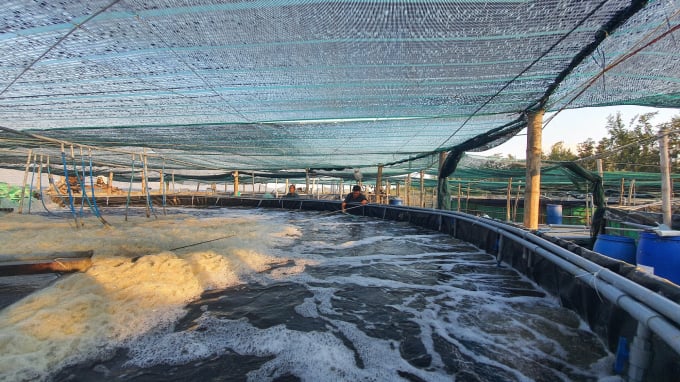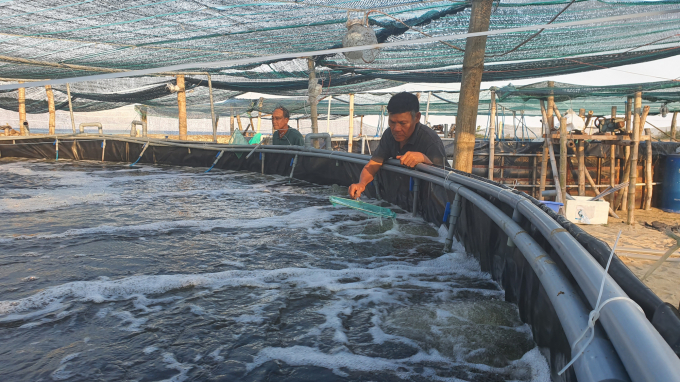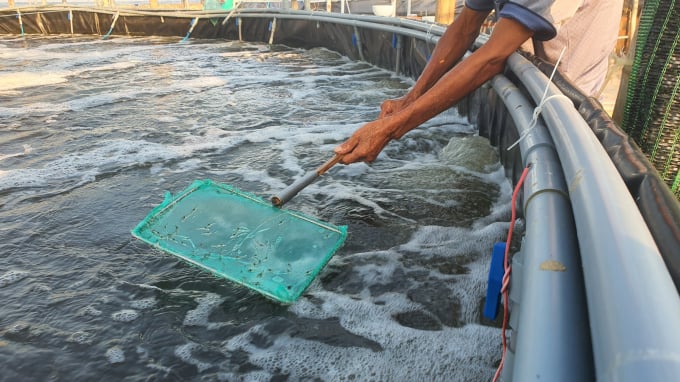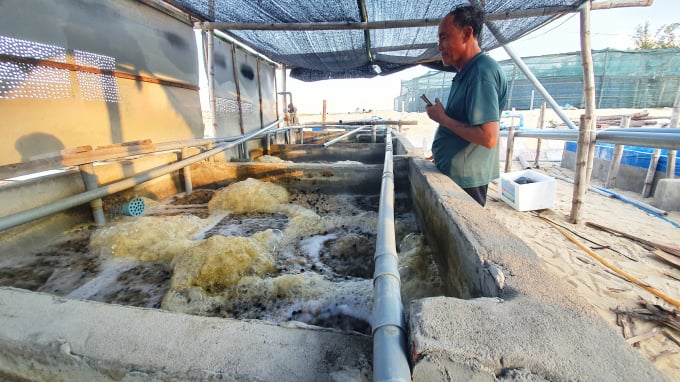December 6, 2025 | 07:26 GMT +7
December 6, 2025 | 07:26 GMT +7
Hotline: 0913.378.918
December 6, 2025 | 07:26 GMT +7
Hotline: 0913.378.918

RAS shrimp farming will be divided into 3 stages in different tanks. Photo: L.K.
In recent years, diseases have been appearing on shrimp due to water sources and shrimp farming environment pollution, making many farmers suffer heavy losses. Therefore, the application of advanced technologies to treat water and ensure the best living conditions for shrimp is extremely necessary.
On that basis, in 2020, a research project on applying technology to stabilize the water environment in super-intensive shrimp farming ponds has been implemented.
The project is carried out by SAEN Environmental and Aquaculture Science Co., Ltd, with Dr. Nguyen Nhut, Deputy Head of Experimental Biology Office, Research Institute of Aquaculture No. 2 as the project leader.

The water in the shrimp pond is recirculated after treatment and always keeps the indicators stable to ensure the best living environment for shrimp. Photo: L.K.
The model is deployed in Duc Chanh commune (Mo Duc district), on a scale of 700m2. Shrimp farming will be divided into three stages in different tanks. In the first stage, seeds were stocked in a 100m2 tank at a density of 1,020 shrimp/m2. When shrimp enter the 2nd month, they will be transferred to another 200m2 tank. In the final stage, they will be raised in a 400m2 tank.
Following this technology, the entire farming area uses tarpaulin-lined iron frames. In particular, during the rearing process, there is no need to change the water at all since the cultivating environment will be continuously treated through 2 solid-waste treatment systems with membranes and dissolved waste using microorganisms.
The water in the pond circulates continuously, and after being treated, the water for shrimp farming returns to the lake to ensure clean and safe criteria for shrimp to grow, minimizes disease and uses completely zero antibiotics.

Raised shrimp live in a clean water environment, which will minimize disease while not using antibiotics. Photo: L.K.
“… Because this technology does not change the water, it will prevent the transmission route of the disease source following the changed water. In addition, when rearing in 1 month each, when the pathogen has not yet developed, we have already cleaned and put the shrimp back in”, claimed Dr. Nguyen Nhut.
In Vietnam, the model deployed in Duc Chanh commune is the first model to be deployed on a household scale. Compared to the application in the Institute of Fisheries, household farming will have adjustments to simplify all processes, omitting some stages to help farmers easily perform.

The microbiological treatment system will remove dissolved wastes and return clean water to the tank. Photo: L.K.
Regarding the possibility of widespread application of the model when the technology is proven effective, in accordance with Mr. Nhut, it will take about 6 months for farmers to understand and put the model into practice. Because the problem with this system is that the person operating the recirculation system does not know how to raise shrimp and the farmer does not understand how the system works.
“This is still the biggest failure of the RAS technology. In order to operate the system, one must possess lots of knowledge from farming, mechanics, water quality to chemistry, biology... Therefore, although this technology has the highest density, I am choosing a moderate level for farmers to learn. During the training process, they will gradually gain knowledge and increase the farming density to increase economic efficiency", said Mr. Nhut.
According to Mr. Nguyen Van Thanh, Director of the Department of Science and Technology of Quang Ngai province - the project's advisory unit, after nearly a year of implementing the model locally, RAS technology has shown initial results, farmed shrimp grew and developed well with zero diseases detected.
In the near future, at the end of the project, we will re-evaluate its effectiveness. On the practical basis, we will open a training class for about 50 farmers to access the technology, then later apply it into practice, increase economic efficiency, also gradually replicate in order to sustainably develop the province's shrimp farming", shared Mr. Thanh.

(VAN) After three years, Project FST/2020/123 collected approximately 3,000 insect specimens, classified them into about 50 morphological groups, and identified around 40 species, including several new species.
/2025/12/01/0509-2-175427_206.jpg)
(VAN) Emission-reducing coffee areas in Lam Dong have entered the new crop with stable yields, improved quality, and a remarkably enhanced cultivation environment.

(VAN) The Institute of Agricultural Sciences for Southern Vietnam (IAS) marked its 100th anniversary in Ho Chi Minh City, celebrating a century of growth as a leading institute contributing significantly to Viet Nam’s agricultural development.

(VAN) An increasing number of livestock farms are using biogas generators to create a source of renewable electricity, helping to save costs and mitigate environmental pollution.

(VAN) Small changes in rice cultivation, from irrigation methods and straw collection to input management, are paving a new way for Vietnam's agriculture in the journey toward emission reduction.

(VAN) With the project of converting biogas into renewable electricity, Australia is both helping pig farms reduce their energy costs by up to 25% and contributing to environmental protection.
![Hue aims for Net Zero: [1] Initial steps from green transportation](https://t.ex-cdn.com/nongnghiepmoitruong.vn/608w/files/huytd/2025/11/28/0853-anh-6-giao-thong-xanh-hue-094717_940-153724.jpg)
(VAN) For sustainable development, Hue City is implementing many solutions to promote green transportation, which is an important initial step on the journey to building a Net Zero Hue.